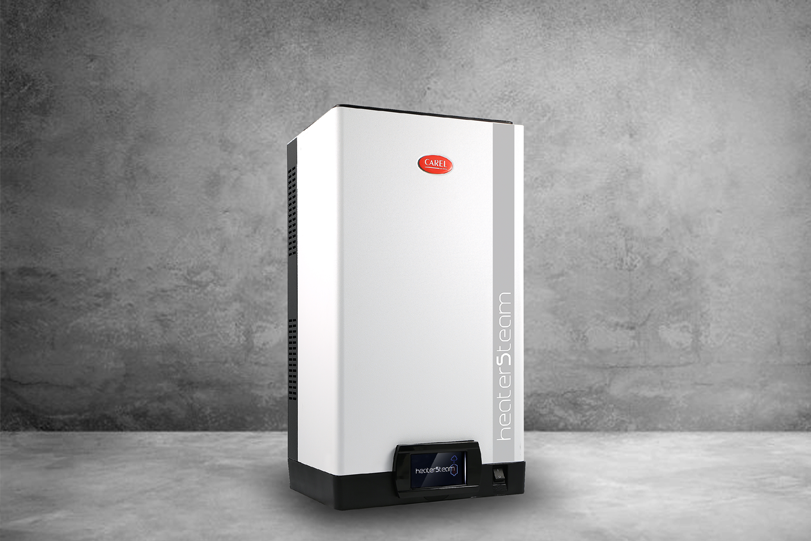The processes that take place inside a clean room are considerably influenced by the thermodynamics of the air. Humidification plays a primary role in controlled-contamination environments, where the processes have high value, and the absence of or incorrect humidity control can cause irreparable defects. The problems that may occur are described below, together with the technologies available on the market to manage humidity in this mission-critical application.
Relative humidity, measured as a percentage of saturation, decreases whenever the air is sensitively heated, or due to migration of moisture content as a result of different partial vaporisation pressures between two adjacent rooms. These situations occur above all in winter, and in particular in systems with all outside air, when the incoming air,with a high relative humidity and low temperature, is heated considerably. The processes performed inside clean rooms are usually delicate, and of high value. To avoid alterations, every technical aspect of the clean room is designed with special attention to factors that may negatively affect the end result, including incorrect or indeed no relative humidity control. If relative humidity is too low <30 per cent, electrostatic discharges may be triggered quite readily, thus compromising the correct operation of electronic equipment.
The speed of chemical reactions also depends on the moisture content of the air, which therefore plays a fundamental role in achieving a high quality product. Another example is semiconductors, comprising electrical circuits that are increasingly close together as a result of the latest technologies. The moisture content of the air must therefore be controlled, to avoid electrostatic discharges and short circuits. Controlling and maintaining relative humidity between 40 per cent and 60 per cent thus minimises the proliferation and spread of bacteria and other biological contaminants. This range of values also represents the comfort zone for people, avoiding dryness in the respiratory system when lower than 40 per cent and discomfort due to levels above 60 per cent. Worker efficiency is improved due to higher comfort and less spreading of viruses and diseases, consequently reducing absenteeism.
To increase the moisture content of the air, there are two possible thermodynamic transformations: isothermal or adiabatic
The former, done using isothermal humidifiers (energy consumption of about 750 W/(kg/h)), involves adding steam to the air. The change of state from liquid to vapour takes place inside the humidifier, which can use different sources of energy; mainly electricity or gas. The difference between the enthalpy of the steam introduced into the room and the enthalpy of the vapour already in the air is limited; for this reason, the transformation causes only a small increase in temperature and hence the process is called isothermal. Steam is intrinsically hygienic and does not need any further treatment before being introduced into the ducting. Isothermal technology is widely used in confined spaces, exploiting the high capacity of steam to be absorbed by the surrounding air.
Airlocks, typically used in clean rooms to move between areas with different ISO classes, have a dedicated HVAC system that keeps the air temperature humidity conditions and particle content in line with those of the area with the strictest requirements. Isothermal humidifiers are ideal for re-establishing the correct level of relative humidity in airlocks whenever operators pass through. Some models are equipped with a preheat function, which keeps the water inside the boiler at about 80°C by default (other values can be set), ensuring a quick response when humidity is required.
A diabatic humidifiers, on the other hand, exploit the evaporation of water, atomised into small droplets, in the air stream, without adding any external energy. The purpose of these humidifiers is to create a large exchange surface between air and water in the liquid state, consuming energy only to atomise the water. It is important to clarify that the total energy required by the system does not change with respect to isothermal humidification; in adiabatic humidification, however, the bulk of the energy needed to evaporate water is provided by the surrounding air, thus both humidifying and cooling the air at the same time. For this reason, when there are thermal loads in the humidified space or during the summer, adiabatic humidification can have the dual advantage of both humidifying and exploiting evaporative cooling to save on the air-conditioning. There are essentially two adiabatic humidifier technologies available on the market that are suitable for use in clean rooms: high pressure and ultrasonic humidifiers.
High pressure humidifiers are widely used because they can handle medium-to-high humidification loads with a low running cost (energy consumption approx. 4W/(kg/h)). Furthermore, their distribution system guarantees high absorption efficiency (ratio of water absorbed to water atomised). Ultrasonic technology, on the other hand, is better suited to lower humidification loads. Humidifier control, together with the correct positioning of the probes inside the AHU, play a fundamental role in the reliability and maintenance of set point stability. To guarantee high hygiene standards, it is recommended to add a reverse osmosis water treatment system upstream of the humidifiers. This also makes it possible to avoid introducing solid particles (mineral salts) that would rapidly block the filters in the HVAC system. Water purified by reverse osmosis is very aggressive, and therefore suitable materials such as AISI 304 stainless steel must be used to ensure proper functioning of the system and prevent corrosion.
As has been seen, relative humidity needs to be managed and controlled not only to prevent defects in the end product, but also for the comfort of operators. Energy consumption varies substantially between isothermal and adiabatic solutions, however, despite being very important, this is not the only factor to take into account when choosing the best humidification system. Often it is a matter of making the best trade-off between humidification load, expected operating hours, budget, installation simplicity and any surrounding conditions.
Authored by:
Massimiliano Maistro
CAREL Application Specialist – HVAC Industrial
Cookie Consent
We use cookies to personalize your experience. By continuing to visit this website you agree to our Terms & Conditions, Privacy Policy and Cookie Policy.















